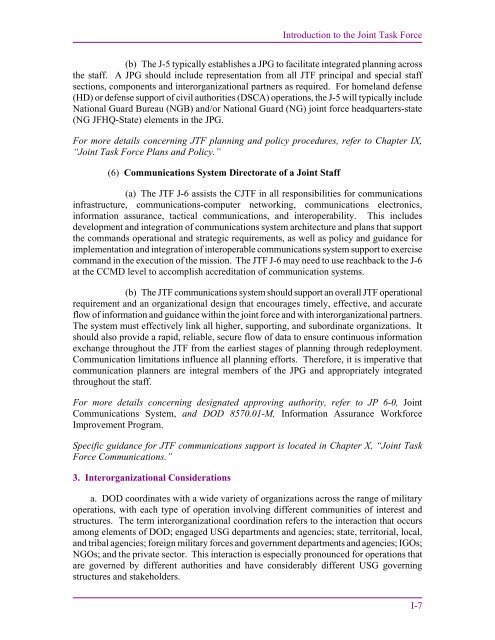JP 3-33, Joint Task Force Headquarters - Defense Innovation ...
JP 3-33, Joint Task Force Headquarters - Defense Innovation ...
JP 3-33, Joint Task Force Headquarters - Defense Innovation ...
You also want an ePaper? Increase the reach of your titles
YUMPU automatically turns print PDFs into web optimized ePapers that Google loves.
Introduction to the <strong>Joint</strong> <strong>Task</strong> <strong>Force</strong><br />
(b) The J-5 typically establishes a <strong>JP</strong>G to facilitate integrated planning across<br />
the staff. A <strong>JP</strong>G should include representation from all JTF principal and special staff<br />
sections, components and interorganizational partners as required. For homeland defense<br />
(HD) or defense support of civil authorities (DSCA) operations, the J-5 will typically include<br />
National Guard Bureau (NGB) and/or National Guard (NG) joint force headquarters-state<br />
(NG JFHQ-State) elements in the <strong>JP</strong>G.<br />
For more details concerning JTF planning and policy procedures, refer to Chapter IX,<br />
“<strong>Joint</strong> <strong>Task</strong> <strong>Force</strong> Plans and Policy.”<br />
(6) Communications System Directorate of a <strong>Joint</strong> Staff<br />
(a) The JTF J-6 assists the CJTF in all responsibilities for communications<br />
infrastructure, communications-computer networking, communications electronics,<br />
information assurance, tactical communications, and interoperability. This includes<br />
development and integration of communications system architecture and plans that support<br />
the commands operational and strategic requirements, as well as policy and guidance for<br />
implementation and integration of interoperable communications system support to exercise<br />
command in the execution of the mission. The JTF J-6 may need to use reachback to the J-6<br />
at the CCMD level to accomplish accreditation of communication systems.<br />
(b) The JTF communications system should support an overall JTF operational<br />
requirement and an organizational design that encourages timely, effective, and accurate<br />
flow of information and guidance within the joint force and with interorganizational partners.<br />
The system must effectively link all higher, supporting, and subordinate organizations. It<br />
should also provide a rapid, reliable, secure flow of data to ensure continuous information<br />
exchange throughout the JTF from the earliest stages of planning through redeployment.<br />
Communication limitations influence all planning efforts. Therefore, it is imperative that<br />
communication planners are integral members of the <strong>JP</strong>G and appropriately integrated<br />
throughout the staff.<br />
For more details concerning designated approving authority, refer to <strong>JP</strong> 6-0, <strong>Joint</strong><br />
Communications System, and DOD 8570.01-M, Information Assurance Workforce<br />
Improvement Program.<br />
Specific guidance for JTF communications support is located in Chapter X, “<strong>Joint</strong> <strong>Task</strong><br />
<strong>Force</strong> Communications.”<br />
3. Interorganizational Considerations<br />
a. DOD coordinates with a wide variety of organizations across the range of military<br />
operations, with each type of operation involving different communities of interest and<br />
structures. The term interorganizational coordination refers to the interaction that occurs<br />
among elements of DOD; engaged USG departments and agencies; state, territorial, local,<br />
and tribal agencies; foreign military forces and government departments and agencies; IGOs;<br />
NGOs; and the private sector. This interaction is especially pronounced for operations that<br />
are governed by different authorities and have considerably different USG governing<br />
structures and stakeholders.<br />
I-7

















